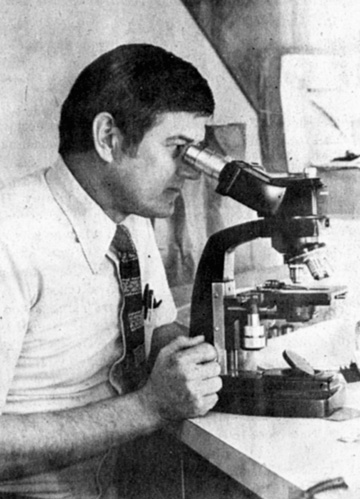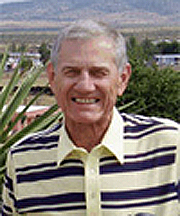| Something About Mike
.....
|
Powell Named Head of Biology Department
|

Dr. A. Michael Powell, Professor
of biology at Sul Ross, peers through a microscope to collect data for
a National Science Foundation research project he is presently conducting.
|
ALPINE: Dr. A. Michael Powell, professor of biology at Sul
Ross State University, has been appointed chairman of the Department of
Biology effective the beginning of the 1978 fall semester, said Sul Ross
President Bob Richardson today. Dr. Barton Warnock, who has served
as chairman of the department since 1947, will continue his full time duties
as distinguished professor of biology at Sul Ross. Powell received
his B.S. and M.A. degree from Sul Ross in 1960 and his Ph.D. from UT-Austin
in 1963. He is a graduate of Coleman High School and is the son of
Mr. and Mrs. Everett Powell of Coleman. He was recently selected
as one of two Texas scientists to serve on the National Science Foundation
review panel that reviews all systematic biology.
(Coleman Democrat-Voice, Coleman,
Texas, July 8, 1978, page 7-A)
|
From the Sul Ross website:
A. Michael Powell
Professor
Director and Curator, Sul Ross State University Herbarium (SRSC)
Education:
Ph.D. 1963 The University of Texas at Austin
M.A. 1960 Sul Ross State University
B.S. 1960 Sul Ross State University
A.A. 1957 Howard County Junior College
Research Interests:
Plant Systematics, emphasizing field, morphological, cytological, cytogenetic,
and artificial hybridization approaches.
Floristics of the northern Chihuahuan Desert Region, including Trans-Pecos
Texas.
Cactaceae of Trans-Pecos Texas
Rare plants of Trans-Pecos Texas
Native plant horticulture
Economic plants for arid lands
Revegetation of disturbed habitats in the Chihuahuan Desert Region
Publications:
Over 100 articles in professional journals
Books in print:
Grasses of the Trans-Pecos and Adjacent Areas
Trees and Shrubs of the Trans-Pecos and Adjacent Areas
Affiliations:
Regional, national, and international botanical and biological societies
Chihuahuan Desert Research Institute (CDRI), Board of Directors, Board
of Scientists
Desert-Mountain Times
Art & Culture: Sul Ross cactus garden is more than meets the
eye
April 7, 2005
By Elizabeth McBride
In the 1960s and 1970s, Dr. A. Michael Powell of
the Biology Department at Sul Ross State University proposed a cactus garden
to include all specimens of cacti indigenous to the Chihuahuan Desert as
it overlaps the Trans-Pecos, a vast arid land which includes more species
of cacti than are found in the Sonora Desert and more than are found in
Arizona. The board of regents did not favor Powellís proposal.
Years went by. Then, finally, in preparation for Sul Rossí Diamond
Jubilee celebration in 1996 and the renovation of Lawrence Hall, the potential
drama of such a unique garden was recognized.
The architect built the formal brick edging, and
Powell was called to make the garden. He wanted a hybrid form: a
combination of classically ordered beds with the presentation of cacti
much as it is in its natural habitat. To avoid hurting the Earth,
some specimens would be collected, but most would come from the universityís
greenhouses, having been propagated from seeds and cuttings. The
first planting was by Dr. Powell, Mrs. Powell and a student assistant with
the help of Jack Brady, the first environmental science technician, who
had procured a lot of original plants himself. Brady was soon succeeded
by Patty Manning. Patty had been an engineer technician for the Texas
Highway Department, specializing in native plant landscape. Hired
at Sul Ross in 1996, she was, according to Dr. Powell, a perfect match.
"Manning knows how fields and habitats work and has a powerful visual imagination
and memory," Powell said. Since her first involvement with the Sul
Ross cactus garden, Manning has concentrated on individual beds/gardens
to create within them a closer representation of their natural environments.
But the garden allows also for larger applications and studies. Areas
that Manning has an interest in are population genetics, variability within
species, the study of genetic inheritance and morphological similarity
and divergence.
Itís difficult to describe just what is so charming
about this relatively small garden. I'd walked right past it to Lawrence
Hall without even becoming aware of it. So for me, it was an exciting
discovery, and each miniscule species of cactus seemed like a happy revelation.
Perhaps some of the "specialness" comes from seeing everyday plants set
into a habitat that leads us to consider them anew. Some of the great
gardens we know of, vistas from palaces in France and England, are primarily
about a traditional order. Other great gardens, such as Hampstead
Heath in London or our own Central Park in New York, are experiments in
wildness, efforts to give citizens a respite from their gritty urban environment
and connect them once again to their relationship with the fertile Earth.
We do have a city park. But with the Big Bend National Park and the
new state park so close, and with a majestic landscape in every direction,
perhaps we donít need such a complete escape as much as those surrounded
by a gritty urban environment.
Landscape architecture is a discipline which negotiates
between architects, designers and gardeners. Beth Francell is a local
citizen who went back to school to earn the credentials recommended for
the trade. But itís a discipline that can be practiced without the
normal credentials. And the cactus garden at Sul Ross is one of Francellís
favorites. "I've always loved it," she said. And the profession
is still fluid. The garden at the new Getty Museum in California,
for example, was designed by the artist Robert Irwin. It seems delightful
that there is still such freedom in a traditional art form and exciting
that this small jewel of a garden is right here in Alpine. |
|

